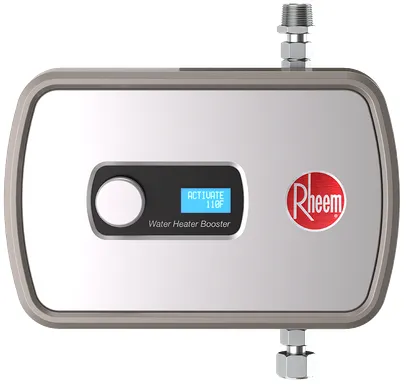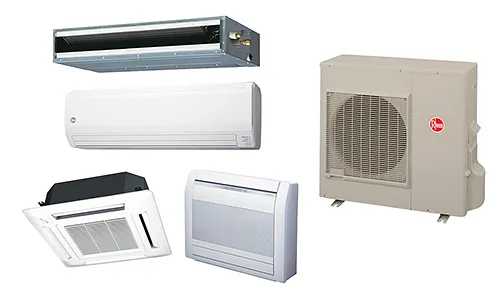Extra Products to Improve Household Efficiency
Optimizing your home for efficiency can feel overwhelming. Everything from the walls of the house itself, to the building products that help enclose it, to the fixtures and appliances you install inside will contribute to its overall efficiency. There are tons of big-ticket items to consider, but you can also make an impact with smaller products that pack a punch. Here are a couple of ideas you can use whether you’re building new or renovating an existing home!
The
Rheem® Water Heater Booster works with electric and gas tank heaters of all sizes to provide up to 45% more hot water on demand as necessary. This means you can get by with a smaller tank that uses less energy!
A Hot Water Booster
Tank water heaters have been the norm for quite some time, and many homeowners continue to favor them despite the remarkable efficiency of newer tankless water heaters. Some simply prefer what they already know, and others like having a tank of hot water stored up in case the power goes out. Whatever the case, did you know that you can effectively expand the volume of an electric or gas water heater with an add-on that works similar to a tankless heater? Enter the hot water booster!
A hot water booster is only about the size of a tablet, but it can increase hot water output by up to 45%. It installs over the tank and will kick on when the outlet water—that is, the water leaving the tank to reach your fixtures—drops below a set point. Depleting your hot water storage used to mean you’d have to deal with cold water or wait until the tank came up to temperature again, but with a booster, you can effectively stretch the amount of hot water available as needed. That standard 50-gallon tank can have an output of 80 gallons!
So, what does this mean for efficiency? You can enjoy the benefits of having a hot water reservoir and the energy savings of tankless heating! Feel free to invest in a smaller tank—it’ll cost less up front and will save on utilities going forward. Many also choose to add a booster to their existing heater to make up the difference for a growing household that needs more hot water than it did in the past. Tank heaters are on constantly to keep hot water ready when you want it, so reducing the amount of energy needed for that will help decrease your consumption overall. Be sure to ask a professional’s opinion if you’re unsure what size tank you should pair with a booster to get the best results for your family.
Mini-split systems are composed of indoor (left) and outdoor (right) units connected by thin tubing that transfers heat in or out of your space as needed. There are single- and multi-zone options to suit your needs for a single room or the whole house!
Mini-Split Heating & Air Conditioning
Most homes in the United States have central heating, ventilation, and air conditioning (HVAC), but that’s not the only option. Mini-split systems also provide heating and cooling in a zoned, room-by-room format that offers greater efficiency. Why waste energy with climate control where you don’t need it? With mini-splits, you can easily adjust individual room units to keep you comfortable in living areas during the day and in the bedroom at night—or whatever works for you!
Mini-split systems use a heat pump to transfer heat from outside into the house when it’s cold and out of the house when it’s hot. You can learn how it works in our article, All About Heat Pump Technology. For our purposes here, all you need to know is that heat pumps are exceptionally efficient because they don’t create heat like traditional furnaces do. They use a small amount of electricity to transfer it, and the zoned aspect of mini-split systems makes it possible to maximize the effect you feel inside while reducing energy consumption. It’s a rare win-win situation for you and the environment.
So, how can you use mini-splits in your home? They can actually serve as your entire, decentralized HVAC system, if you’d like. They also make a great choice for renovations and additions because they don’t require any ductwork, so you won’t have to cut them into any existing system. If your home heats and cools unevenly—all the heat goes upstairs while rooms downstairs remain cold and keep the thermostat running, for instance—then you might want to supplement with a mini-split unit. Just remember to optimize the insulation in your walls and check that your windows and doors aren’t leaking; you don’t want to waste energy trying to maintain the temperature where it won’t stick.
Whatever kind of HVAC or water heating you may need, Rheem® has solutions! Their catalog includes all sorts of efficient appliances for homes of all sizes, no matter where they might be located. There is no one-size-fits-all solution when it comes to these things—everything from your local climate to your family’s lifestyle and preferences need to be considered—so find a professional who can help you navigate the options!



.png)
.png)



